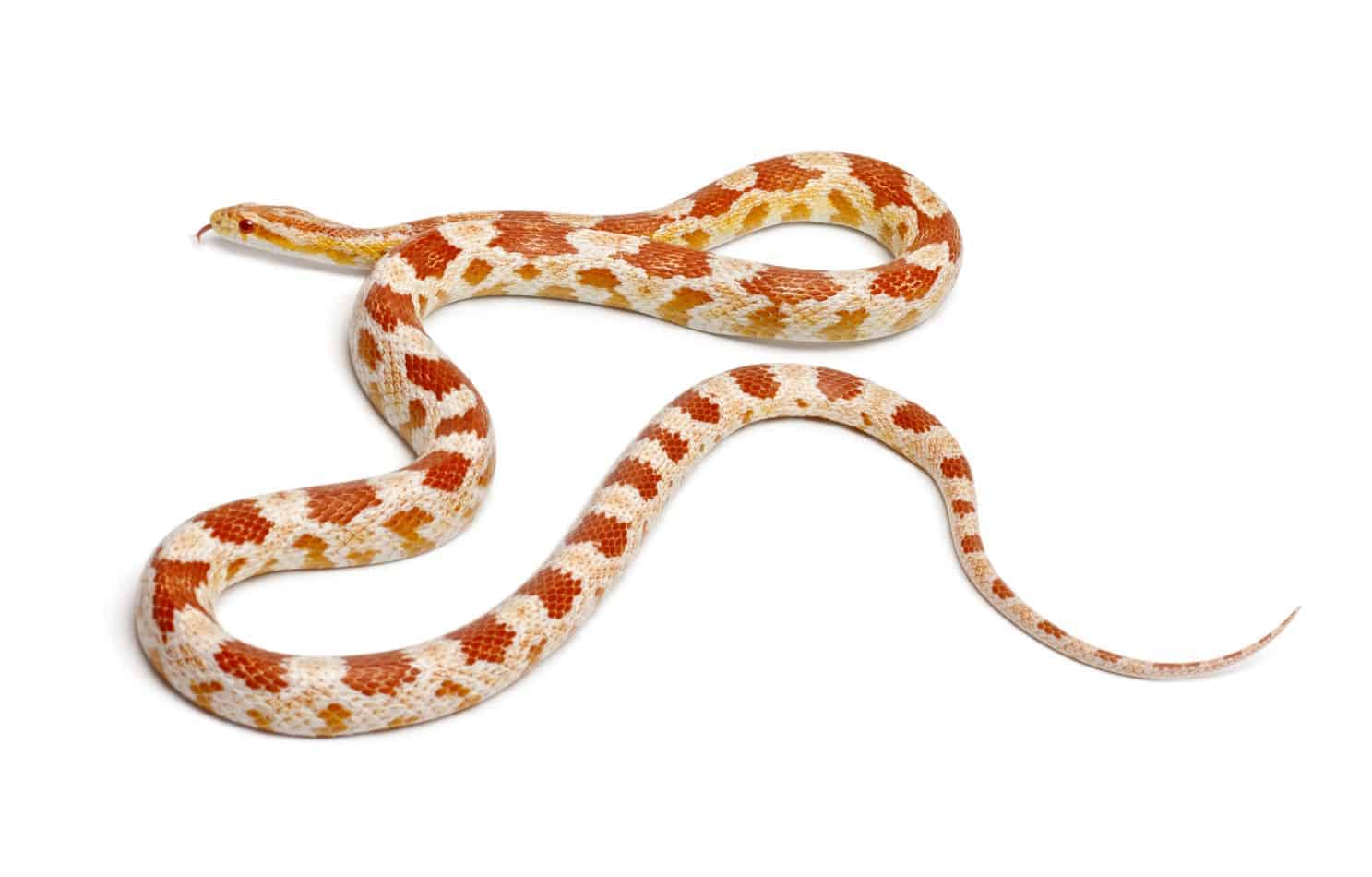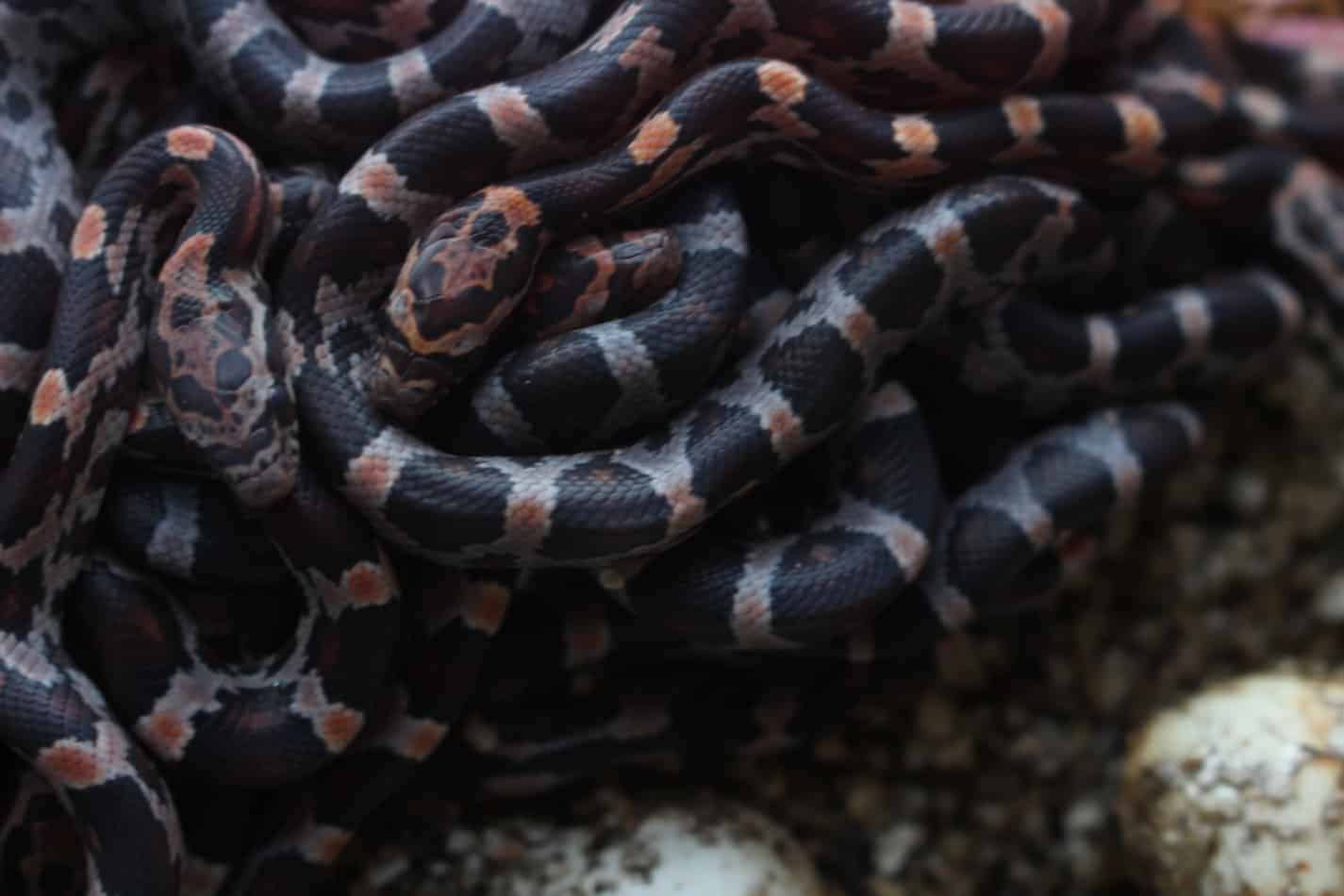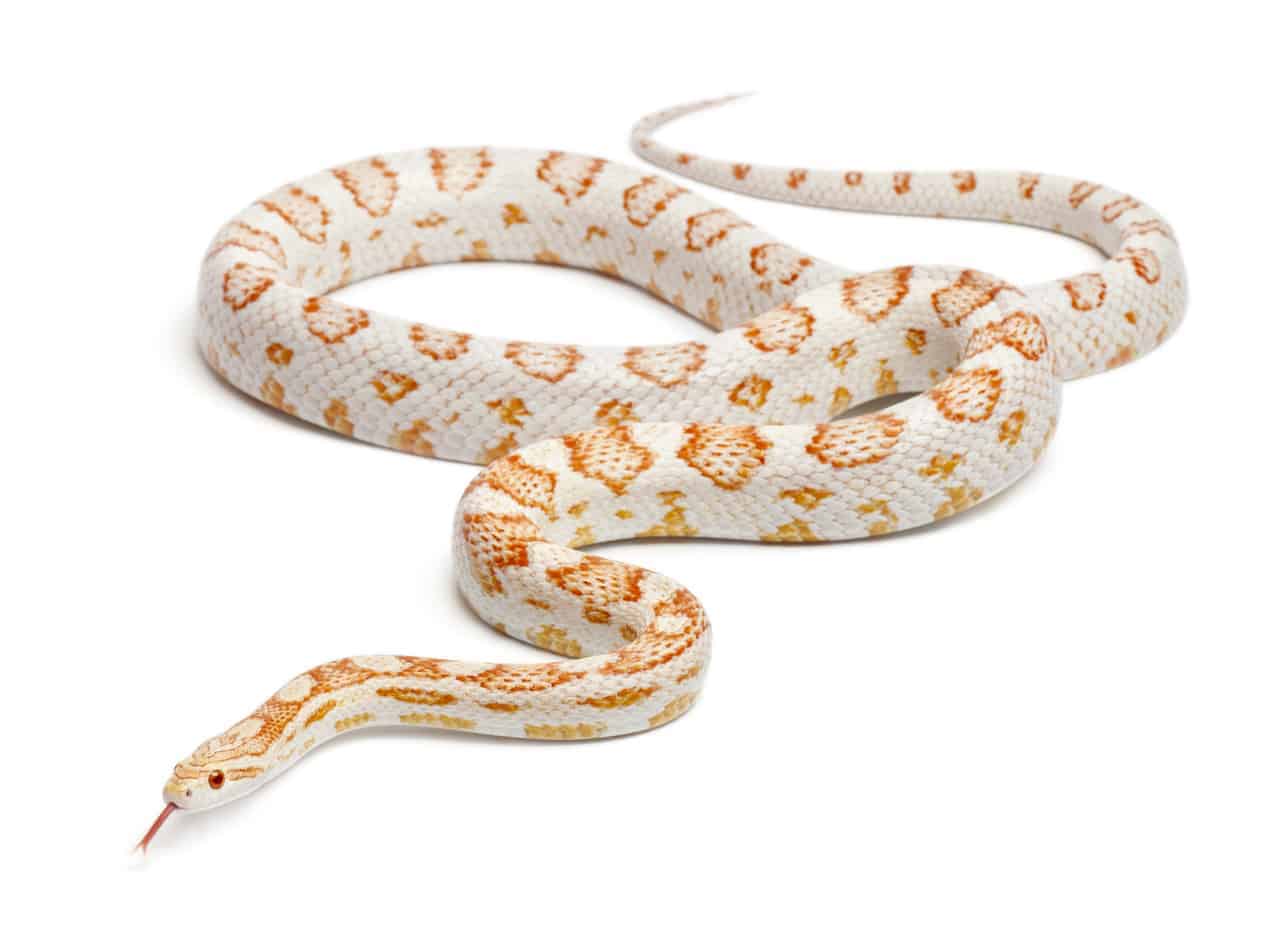Most Popular Corn Snake Morphs (with Pictures and Facts)
I have been looking for pet snakes and as I have been researching, I have become interested in the morphs of corn snakes. There are many morphs of corn snakes that are both interesting and exotic looking: here’s what I found.
What Are The Most Popular Morphs Of Corn Snakes?
So, what are the most popular morphs of corn snakes? The most frequently bought corn snake morphs are the Okeetee corn snake, the Albino corn snake, the Anerythristic corn snake, the Black corn snake, the Blood Red corn snake, the Candycane corn snake, and the Alabama corn snake.
Mother Nature exercised her creative liberties when it came to snake morphs. They are truly each a work of art.
Corn Snakes in General
For the most part, corn snakes are a breed that has red/orange tinted scales with brown spots and sometimes stripes. Corn snakes are constricting snakes so their bites do not carry venom. They are mild mannered and do not mind being handled by people.
Corn snakes are a medium-sized snake. They average at about 4-5 feet in length. In the wild, corn snakes will live for about 7 years. Corn snakes often resemble a dangerous species of snake called copperhead snakes. Because of the confusion, harmless corn snakes are killed by mistake.
In captivity, most morphs of corn snakes will live to be 20 – 25. They may live even longer than that if they are well looked after by their owners. This makes them great life-long companions.
FUN FACT: Corn snakes got their name because their belly scales resemble the pattern found on corn!
Corn snakes like
Corn snakes are a breed of rat snakes. They are called rat snakes because in the wild this breed feeds off of mice and rats. Corn snakes are great for their environments because they are not dangerous to human and eat rats, which often are carriers of diseases.
Corn snakes are active during the day and in the night time but tend to be more nocturnal during the summertime or on other hot days.
How Morphs are Achieved
Morphs are just a label to an occurrence when a snake of the same species looks different or abnormal from the original or “wild-type”. This difference can make an appearance in either color or pattern. For example, most corn snakes have red and orange colors on their bodies but Blizzard corn snakes are all white. Blizzard corn snakes are still corn snakes, they just don’t fit the norm.
Most morphs are achieved today by breeders. Over the course of years, breeders have found corn snakes with different colors and bred them with similar ones to get the most extreme and consistent color/pattern combination. It really breaks down to genetics. New morphs are found and made regularly through the persistence of breeding. To learn more about the specifics of breeding and the genetics of snakes, click here.
Because some morphs are harder than others to get just right, that is to say, that they are healthy and vibrant, they tend to be more expensive. The everyday, typical, “wild-type” corn snake can be bought for around $10 in some places. Most specialty bred morphs are going to be at least 4 times that amount.
Okeetee Corn Snakes

Okkeetee albinos reverse corn snake or red rat snake, pantherophis guttatus
The Okeetee corn snake is easily one of the most popular breeds for corn snakes, and for snakes period. Okeetee corn snakes are known for their black, thick borders around the spots known as saddle marks on the snakes’ back. The thick border creates a distinct look and makes the various markings become more distinct.
The color of the body of the snake is a reddish brown color, sometimes tan with brown spots and some white on the body as well. The stomach is usually tan or off-white. Most of these Okeetee corn snakes have red saddle markings, but they are sometimes orange or a red-brown shade.
The Okeetee morph is said to be the “ideal” looking version of the traditional snake because of the borders found on its body. It exaggerates the great features found on the original or classic snake found in the wild.
This morph was originally found in South Carolina. They are still the average size of corn snakes about 3-5 feet in length. They are thick and hearty. They eat a mouse or a small sized mouse about once every 2 weeks.
Okeetee corn snakes get their name from their region. There is an Okeetee Hunt Club in Jasper County, South Carolina.
Albino Corn Snakes
These corn snakes are quite beautiful to look at. They are a specially bred morph. These little guys are also called amelanistic corn snakes because they lack melanin. Melanin is the pigment in skin or scales that are dark. Albino corn snakes are light in color, nearly white.
Albino corn snakes can also be yellow, pink, red, or orange, or any combination. They will not have dark borders like Okeetee, or any dark colors at all. This makes any patterns not as distinct but still beautiful.
Albino corn snakes are not always white, but there are other morphs that are closer to a pure white snake. There are Snow corn snakes and also Blizzard corn snakes. These morphs have a brighter white color and less visible patterns. However, they are not as popular as pets because they are rarer and more expensive.
Albino corn snakes are at the average length and size for corn snakes. The eat with the same size and frequency as Okeetee corn snakes. Like other corn snakes, they are thick, easy to keep up with and like to be held.
One of the coolest things about this morph has got to be their eyes. Albino corn snakes lack dark pigment in their eyes, which means that they have bright red eyes. This makes for an intimidating and exotic look and also looks very cool if the snake has any red patterns on its back to match. Learn more about the albino corn snake by reading this article.
Anerythristic Corn Snakes
These corn snakes are popular because they’re camouflage. They blend in very well with their natural environment. Anerythristic corn snakes are a morph that lacks in all red pigment. This means that these snakes are: black, brown, white and/or gray.
The saddle markings are usually brown with a darker brown border. This morph is not one of the more exotic looking kinds out there but these snakes look wild and beautiful. The colors, especially when gray, bring contrast wonderfully and make the snake look sleek and dangerous (which is great because they are pretty harmless).
These snakes have a bit of yellow on their stomachs and on their necks. This adds a little bit of color and fun too!
Black Corn Snakes
Black corn snakes are a specially bred
Black corn snakes are mainly black but can have white or grey saddle markings and borders. Sometimes, this is reversed, with a mainly chalky white body with back saddle marks on its body. Usually, the stomach is white and there are white or light grey markings on its head.
This morph has black eyes. They truly are beautiful creatures so it is not hard to see why these guys make popular pets. They might be my favorite one on this list.
These Black corn snakes are not too expensive and make fine pets for beginners. They are about 4 – 5 feet on average and eat pre-killed mice or small rats.
Blood Red Corn Snakes
This morph of corn snake is one of the coolest, scariest, and exotic looking out of the corn snakes. They are known because of their intense and bold red color. It resembles blood. If this was your pet, it could definitely send a chill down your friends or families spine.
Blood Red corn snakes now have been bred to have little to no pattern at all visible on their backs. They appear to be a solid red or sometimes red-orange color.
This morph was originally found in Florida and used to have patterns. Through breeding, the more solid red color has been produced over time. When hatchlings of this morph are born, they have the saddle marks but these patterns fade as the snake grows into adulthood.
There used to be a struggle for a female snake to have the average clutch size (the number of eggs laid at once) but now there is no problem meeting the average of other morphs.
This breed has a mostly white stomach and they
Candy Cane Corn Snakes

Candy cane Corn Snake or Red Rat Snake, Pantherophis guttatus
This morph of the corn snake species is popular because of the white and red skin that makes it look like a candy cane. They can also have more striped-like patterns opposed to the usual saddle markings, making it look even more similar to the Christmas mints. Candy Cane corn snakes are missing the dark pigment in their skin, just like albino snakes.
Sometimes the “red” can be more of an orange color. This doesn’t subtract from the fact that this morph is beautiful. This morph has bright red eyes, similar to other morphs among the corn snakes.
Candy Cane corn snakes on average are 5 feet in length. They have the typical thickness for their breed and feed on pre-killed mice or rats.
This is one of the more exotic and popular morphs within the corn snake species because of the patterns and because the red and white contrast so well with each other. These specialty breeds tend to be more expensive but you can find a Candy Cane corn snake online for around $50. However, all snakes vary in vibrancy and exact pattern.
Alabama Corn Snakes
This morph is found in, you guessed it, Alabama. These guys are known for their black and white checkered bellies. They have brown or tan skin with dark, deep red saddle markings. These saddle markings are usually bordered with dark brown or black. The sides of these snakes are usually not patterned but vary in dark tan or brown color. Because of the coloring on the sides, the saddle markings look more like stripes, which distinguish them even further.
This morph looks dangerous, edgy, and sleek. They are popular because of their dark look. The best thing about corn snakes is that they are easily managed and safe reptiles but can look killer. The Alabama corn snake appears to be deadly which is a great thrill to snake enthusiasts.
These Alabama Natives have been bred by specialists to look even better and distinct than the originals. They look lethal but will be calm and collected in the home of a loving owner.
Other Corn Snake Morphs
In addition, there are a couple of up and comers that are growing in the hearts of the people. Cinder corn snakes and Palmetto corn snakes are increasing in popularity. These snakes all are beauties in their own right and vary from complex colors, spots, and other patterns. They are all moderate in size and have docile temperaments. These aspects make them great pets and crowd pleasers for reptile lovers, too.
The morphs refer to different looks, whether color or pattern within the species of snakes. They all belong to the easy-to-take-care of corn snake breed and are all non-venomous.
Although there are many different morphs not included on this list, corn snakes have one of the biggest varieties in the snake species.
Cinder Corn Snakes
Talk about a Cinder(
This morph got its name because of the color of the snake looks like they have been in cinder or ash. They are not vibrant in color unlike most of their species, which makes it even more unusual and perhaps exotic.
There are still some dull colored saddle markings, but they are brown in this morph’s case. The borders for the saddle markings are wavier than other morphs as well.
Cinder Corns originally come from the Upper Florida Keys. They look similar to Anerythristics Corn Snakes because of the absence of red in their skin.
Out of all of the morphs, the Cinder corn snake might be the most unique. Along with its wavy patterns and dull colors, it is common for this snake to be slimmer too. The slimmer the body, the smaller the mouse to feed. That might just be another reason this morph is becoming more and more popular.
Palmetto Corn Snakes
There is nothing that compares to the look of this snake. With a white – or off-white – body, this snake is flecked with red down its back. One of the most beautiful reptiles on the planet by far. Sometimes the spots on the snakes back are gray as well. If you’re lucky, your snake will have both colors.
This is definitely the most diverse corn snake that I could find. It doesn’t have saddle markings or stripes. There is hardly any pattern at all. Some Palmettos have orange marks on the top of their head.
This morph was found not too long ago. The first breeds for sale came out on the market just in 2011. That was not long ago, especially when it concerns how long a certain animal has been on the earth. Because these guys are new, they are rare and expensive.
I wouldn’t consider them to be beginners pets. Not because the temperament is much different, but the investment is a lot greater. These guys cost anywhere from $400 – $800. The price depends on the size of the individual.
Most people who are buying these snakes at the moment are breeders. The price is too high for the average owner. The list is too long as well. Hopefully, as time goes by, this morph will become more available to the common snake lover. It really is the neatest corn snake out there.
Related Questions
Where can I find a pet corn snake? Pet corn snakes can be bought nearly anywhere online. Most online websites will have ratings, and it’s best to check these ratings and comments before purchasing a snake, to make sure it’s healthy. Corn snakes are also found at Petco and some Walmarts.
Are corn snakes considered small? C
Can corn snakes kill you? Corn snakes may bite, but their bites are not lethal. As constricting snakes, the children are the only ones to worry about when it comes to danger. Adults can unwrap the snake from their bodies if it starts showing aggression.



